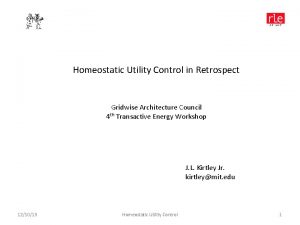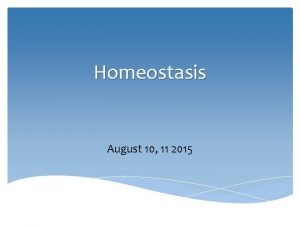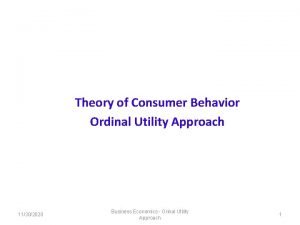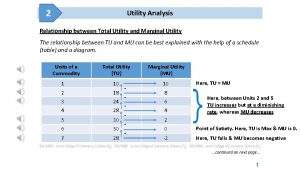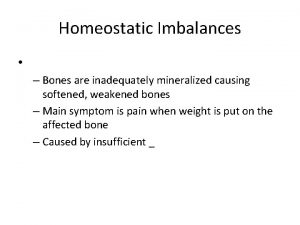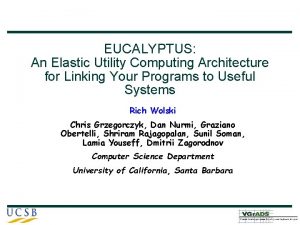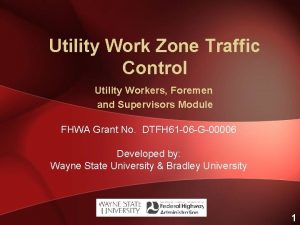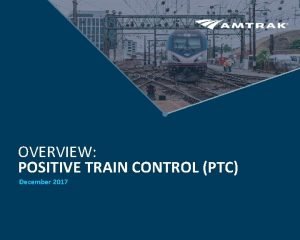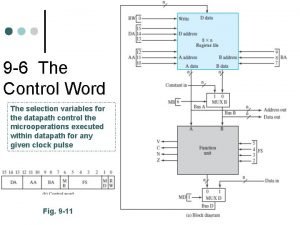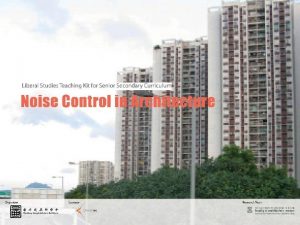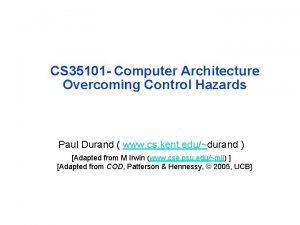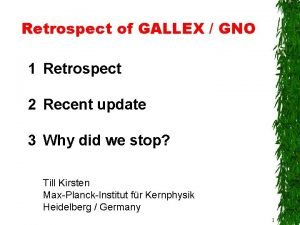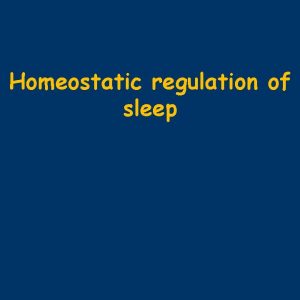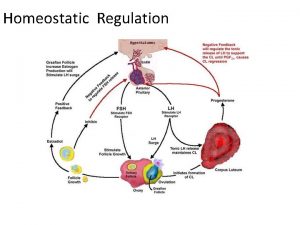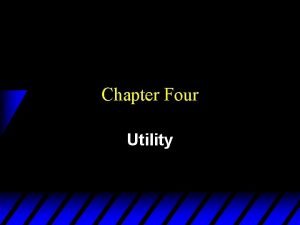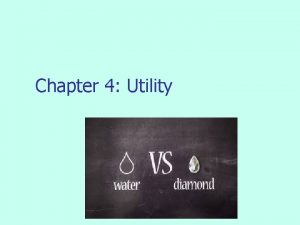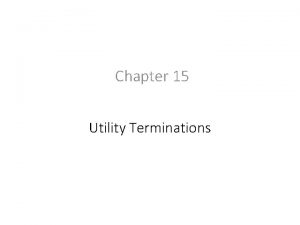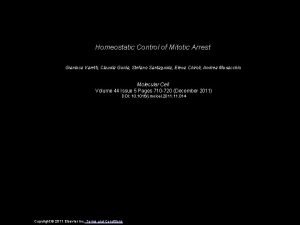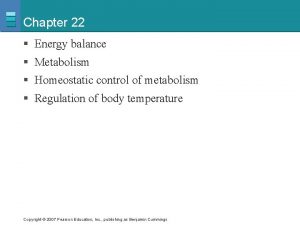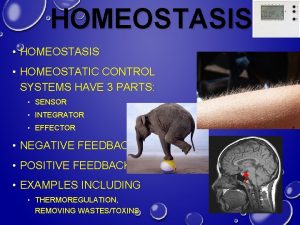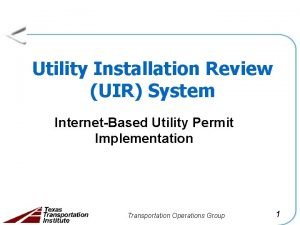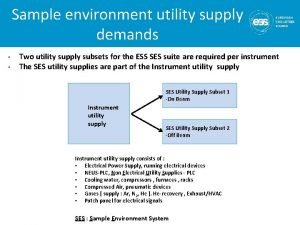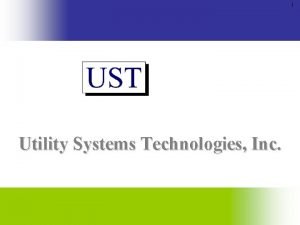Homeostatic Utility Control in Retrospect Gridwise Architecture Council


























- Slides: 26

Homeostatic Utility Control in Retrospect Gridwise Architecture Council 4 th Transactive Energy Workshop J. L. Kirtley Jr. kirtley@mit. edu 12/10/13 Homeostatic Utility Control 1

Homeostatic Utility Control • Arose from an initiative of Fred C. Schweppe and his colleagues in the late 1970’s • Was actually named by Richard Tabors • Was part of Schweppe’s efforts to reinvent the electric utility system • Was intended to make the grid work better • Was developed in the context of regulated public utilities • When first presentation, was rather roundly ridiculed • Has provoked quite a lot of research 12/10/13 Homeostatic Utility Control 2

There were three basic elements of Homeostatic Utility Control: • Frequency Adaptive Power Utility Regulator (FAPER): Fast control • The Energy Marketplace • Marketplace Interface to Customer 12/10/13 Homeostatic Utility Control 3

• Frequency Adaptive Power Utility Regulator (FAPER): Fast control • The Energy Marketplace • Marketplace Interface to Customer 12/10/13 Homeostatic Utility Control 4

FAPER • Intended to replace (or supplement) ‘Spinning Reserve’ • Fast (virtually instantaneous) control • Takes advantage of ‘average power’ or ‘energy’ type loads • Works only within the hysteresis band of an energy load • Within that band, turns load on or off according to frequency 12/10/13 Homeostatic Utility Control 5

FAPER would help the system, but why would customers want to install them? • There is some expense • Probably negligible impact on comfort of equipment operation • Here is Schweppe’s suggestion for compensation • Charge less when frequency is high and more when frequency is low! 12/10/13 Homeostatic Utility Control 6

Later work on FAPERs at MIT: Kevin Brokish • Surprisingly large fractions of consumer loads are amenable to FAPER operation • Brokish assumed operation to be a modification of setpoint in a hysteresis type control 12/10/13 Homeostatic Utility Control 7

Brokish recognized • an instability that can arise with a lot of FAPERS controlling loads by switching them on and off • Loads synchronize with each other • Solution is like Ethernet communications: use probabilistic delay • White band is the dead band • Outside dead band, lighter blue is higher probability of switching 12/10/13 Homeostatic Utility Control 8

12/10/13 Homeostatic Utility Control 9

More Transactive Energy Work: Olivia Leiterman on Storage • FAPER like action need not depend on frequency • Signals from the utility system can initiate change in interchange • Energy Storage is the ultimate in ‘energy’ type load • Here is some motivation for involving real energy wiggles in ‘ancillary services’ 12/10/13 Homeostatic Utility Control 10

‘Power Signal’ could be derived from frequency Or it could be an area power error signal Separating high and low frequency signals 12/10/13 Homeostatic Utility Control 11

Separation of high frequency and low frequency variations • Energy Duration tells what your energy storage is doing • Ramp Duration tells what your other (slower) regulation resources are doing 12/10/13 Homeostatic Utility Control 12

Here is the bottom line: • More to this than can be quickly explained • Longer (slower) frequency cutoff reduces mean ramp rate for thermal units • But it also means more storage energy is required 12/10/13 Homeostatic Utility Control 13

• Frequency Adaptive Power Utility Regulator (FAPER): Fast control • The Energy Marketplace • Marketplace Interface to Customer 12/10/13 Homeostatic Utility Control 14

This is the Energy Marketplace as envisioned by Schweppe in 1980 Note ‘Utility Generation’ is in the ‘Regulated Industry’ 12/10/13 Homeostatic Utility Control 15

In The Energy Marketplace: • There would be a mix of regulated and unregulated generation • Regulation to ensure return to capital and prevent monopoly pricing • Separate ‘buy’ and ‘sell’ prices for customer generation • ‘Time of Day’ pricing was recognized as insufficient • Anticipated automation in customer premises • Recognized that there would be issues with customer acceptance and privacy • And anticipated (maybe incorrectly) that two-way communication with meters might be impractical 12/10/13 Homeostatic Utility Control 16

Later work on Spot Pricing: Jiankang Wang Here we have a pretty generic explanation of why you want to get the final price right 12/10/13 Homeostatic Utility Control 17

In a deregulated market, System operators must buy electricity and keep the system balanced Elasticity Matrix describes • instantaneous elasticity of demand • cross-elasticity (from one time period to others) 12/10/13 Homeostatic Utility Control 18

Demand is determined by a balance • Unit Commitment • Economic Dispatch • Price Elasticity predicts change in demand • But see there are numerous ways things might not balance 12/10/13 Homeostatic Utility Control 19

Better search methods can find the balance 12/10/13 Homeostatic Utility Control 20

• Frequency Adaptive Power Utility Regulator (FAPER): Fast control • The Energy Marketplace • Marketplace Interface to Customer 12/10/13 Homeostatic Utility Control 21

Market Interface to Customer (MIC) • Need to get ‘price’ or ‘prices’ to Customer • Requirement may be only 5 to 10 minutes • Anticipated that there might need to be a confirming signal in reverse • Automation at the customer premises was anticipated • Some form of ‘smart meter’ was also anticipated 12/10/13 Homeostatic Utility Control 22

Market Interface to Customer To avoid this fellow (who Scheweppe anticipated) • Smart Meter does not report on customers in real time • Measures power, multiplies by price, integrates the result 12/10/13 Homeostatic Utility Control 23

Later work at MIT: • ‘The Energy Box’ • Richard Larson and students: • Dan Livengood • Woei Ling Leow • Anticipates forecasts of price, weather, etc. will be required This is an image from Livengood’s thesis, (taken without permission) 12/10/13 Homeostatic Utility Control 24

Current work: using an office building for ancillary services (Young-Jin Kim) Solar Cells Electric Car Charging 12/10/13 Air Conditioner Modulation Homeostatic Utility Control 25

Discussion This work was presented to the IEEE Power Engineering Society Summer Meeting in Vancouver • Charles J. Frank of EPRI told us we were idiots • None of the group had any experience with running a utility • We don’t know what spinning reserve is (misuse the term) • FAPER would cost $60 k • Robert W. Alford of Siemens-Allis said that • Indirect load control would not be effective • Complicated pricing structures require too much customer participation • Confirmation of prices posted every 5 minutes would require too much bandwidth • The Electric Utility Business is not as mature as it used to be. 12/10/13 Homeostatic Utility Control 26
 Gridwise architecture council
Gridwise architecture council Keith haring retrospect meaning
Keith haring retrospect meaning Negative feedback homeostasis examples
Negative feedback homeostasis examples Budget constraint
Budget constraint Relation between marginal utility and total utility
Relation between marginal utility and total utility Homeostatic imbalances of the skin worksheet answer key
Homeostatic imbalances of the skin worksheet answer key Keystone acidosis
Keystone acidosis Carbonic acid buffer system
Carbonic acid buffer system Homeostatic imbalances of the skeletal system
Homeostatic imbalances of the skeletal system Homeostatic regulation usually involves
Homeostatic regulation usually involves Utility computing architecture
Utility computing architecture Utility work zone traffic control
Utility work zone traffic control Utility work zone traffic control
Utility work zone traffic control Pakistan council of architects and town planners
Pakistan council of architects and town planners Glasgow city council building control
Glasgow city council building control National aids control council tenders
National aids control council tenders Software architecture definition
Software architecture definition Return architecture
Return architecture Examples of integral product architecture
Examples of integral product architecture Product architectures
Product architectures Buses in computer architecture
Buses in computer architecture Timing and control in computer architecture
Timing and control in computer architecture Positive train control system architecture
Positive train control system architecture Microprogram sequencer is used in
Microprogram sequencer is used in Example of control word in computer architecture
Example of control word in computer architecture Noise and sound difference
Noise and sound difference Control hazards in computer architecture
Control hazards in computer architecture
